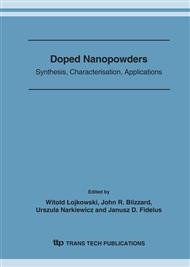p.21
p.25
p.31
p.41
p.47
p.53
p.61
p.73
p.81
The Effects of Oxidized and Oxide-Free Boron on the Mg-B-H Nanohydrides Transformation in the Nearly Nanosized Powders
Abstract:
In this work oxidized and oxide-free amorphous boron (a-B) powder and elemental Mg were used in an attempt to directly synthesize the Mg(BH4)2 complex hydride by controlled reactive mechanical alloying (CRMA) under hydrogen in a magneto-mill up to 200h. The particle size was refined to the 100-200nm range. Nanocrystalline MgH2 (~6nm crystallite size) was formed within the particles when an oxidized a-B is used. In contrast, a mixture of MgB2 and an amorphous hydride MgHx was formed when an oxide-free a-B was used. Differential scanning calorimetry (DSC) test up to 500°C produced a single endothermic heat event at 357.7°C due to hydrogen desorption. In addition, desorption conducted in a Sieverts-type apparatus revealed ~1.4wt.% of hydrogen release. The X-ray diffraction pattern after DSC test of the 200h milled sample made with oxide-free boron showed the presence of MgB2.
Info:
Periodical:
Pages:
47-52
Citation:
Online since:
October 2007
Authors:
Price:
Сopyright:
© 2007 Trans Tech Publications Ltd. All Rights Reserved
Share:
Citation:


